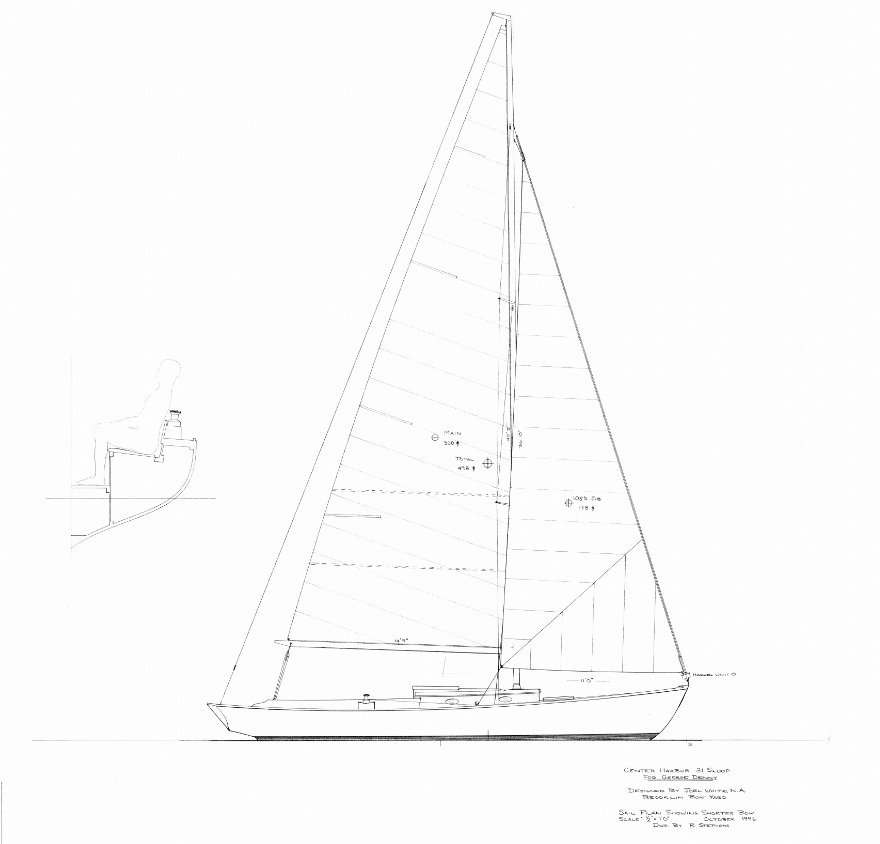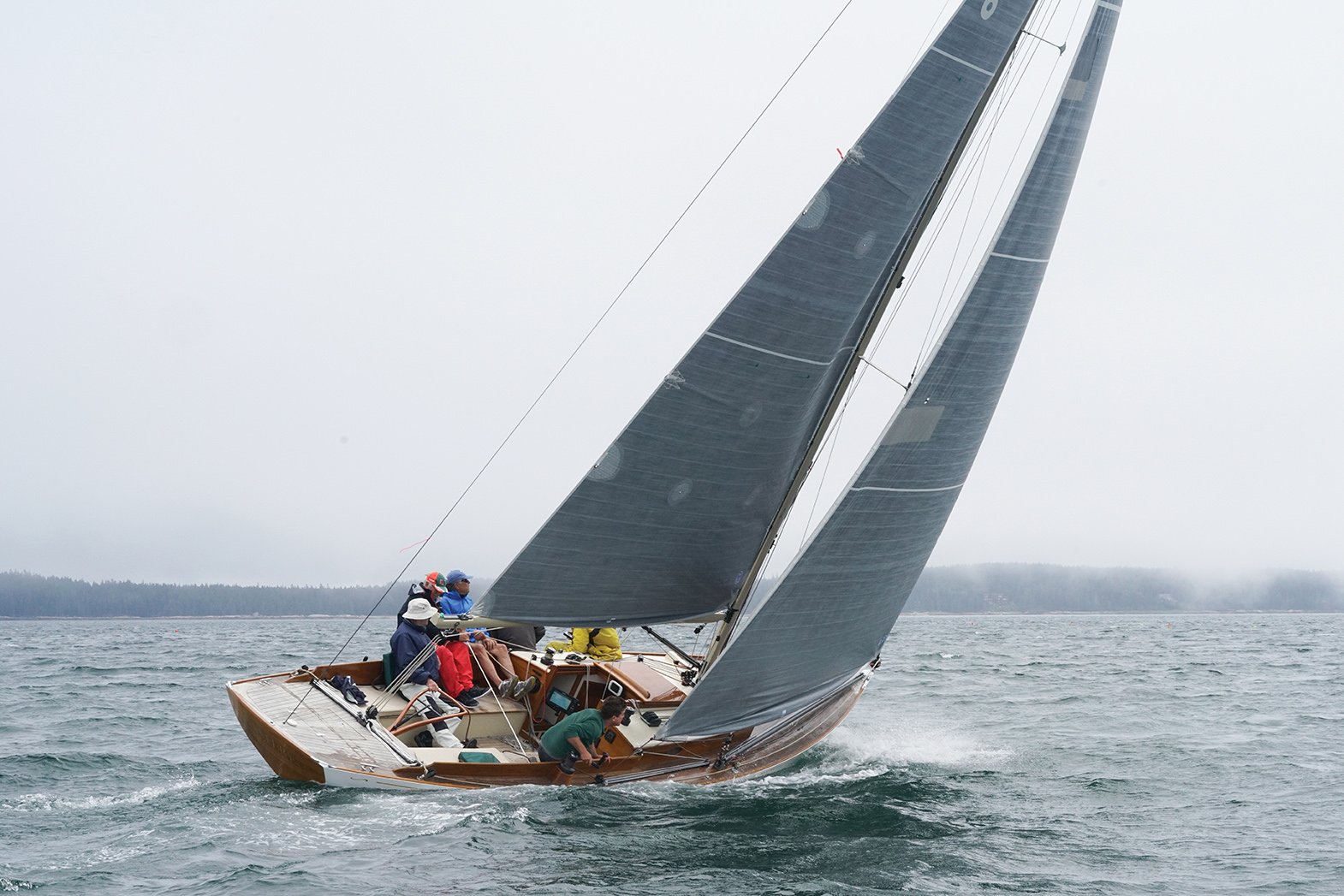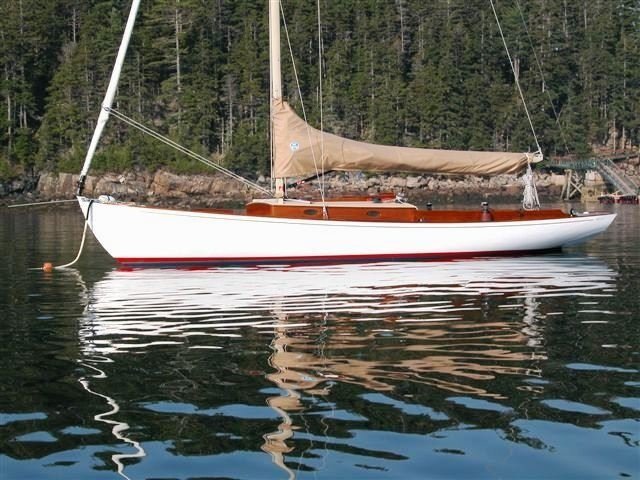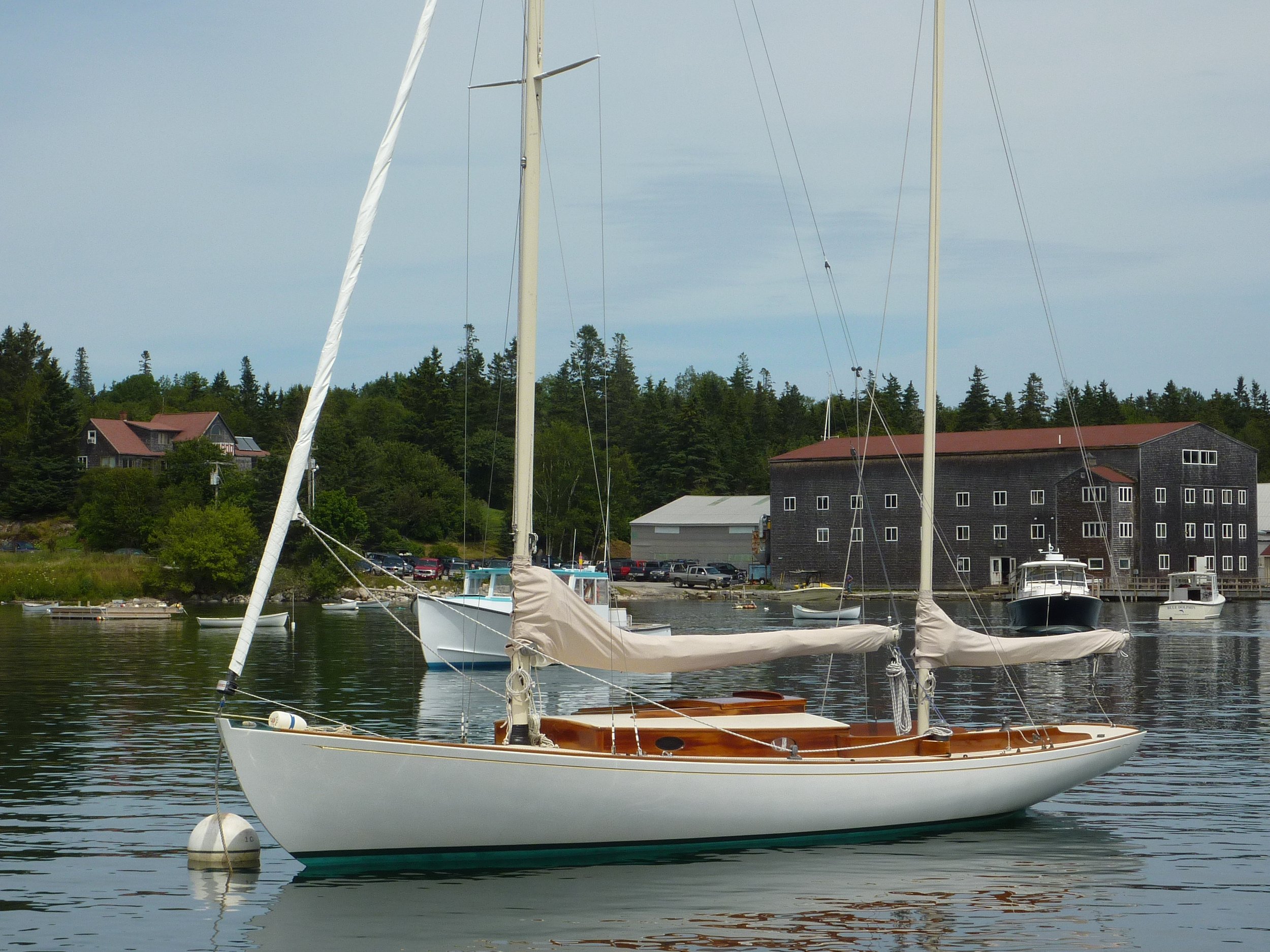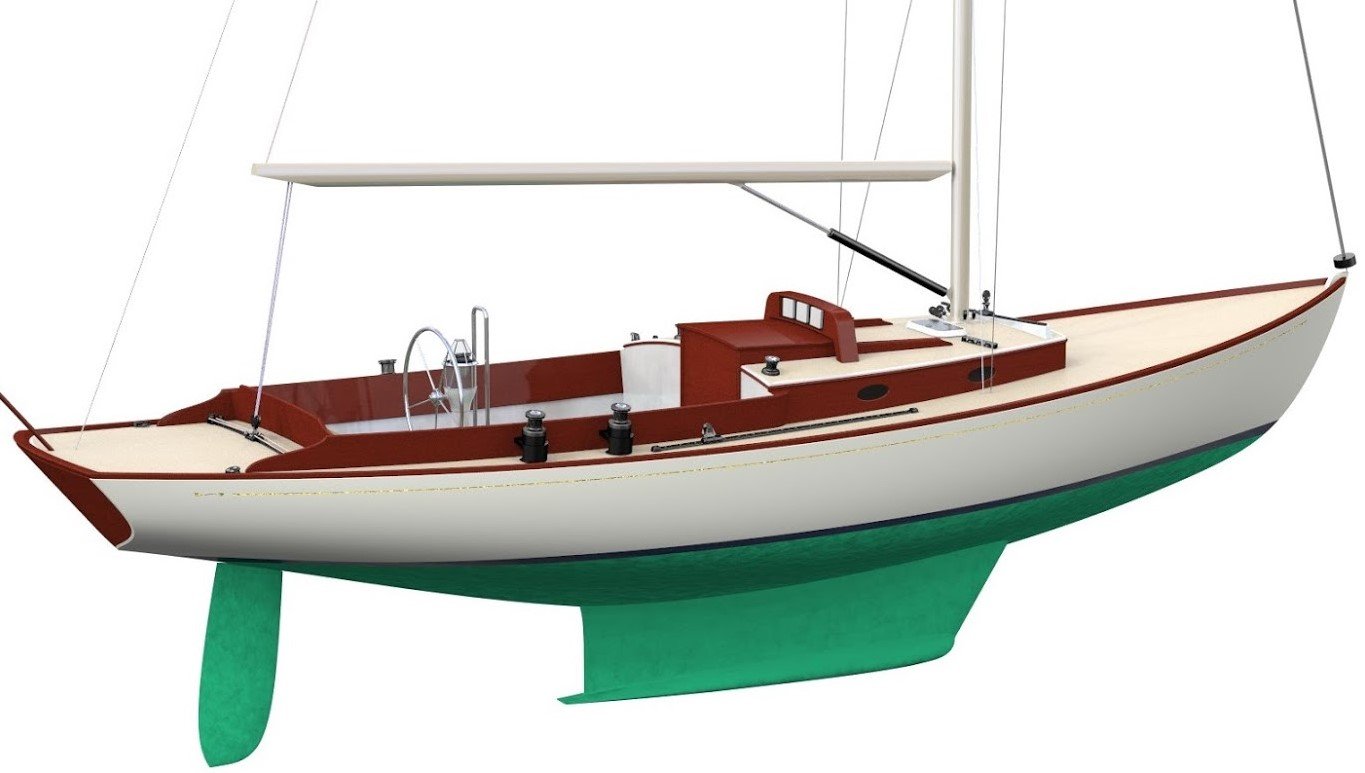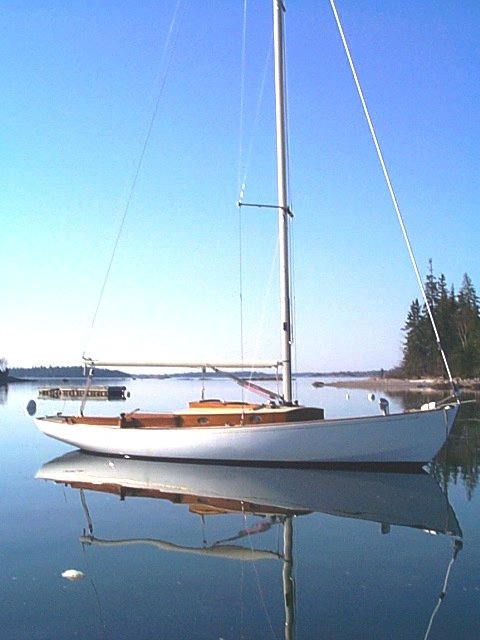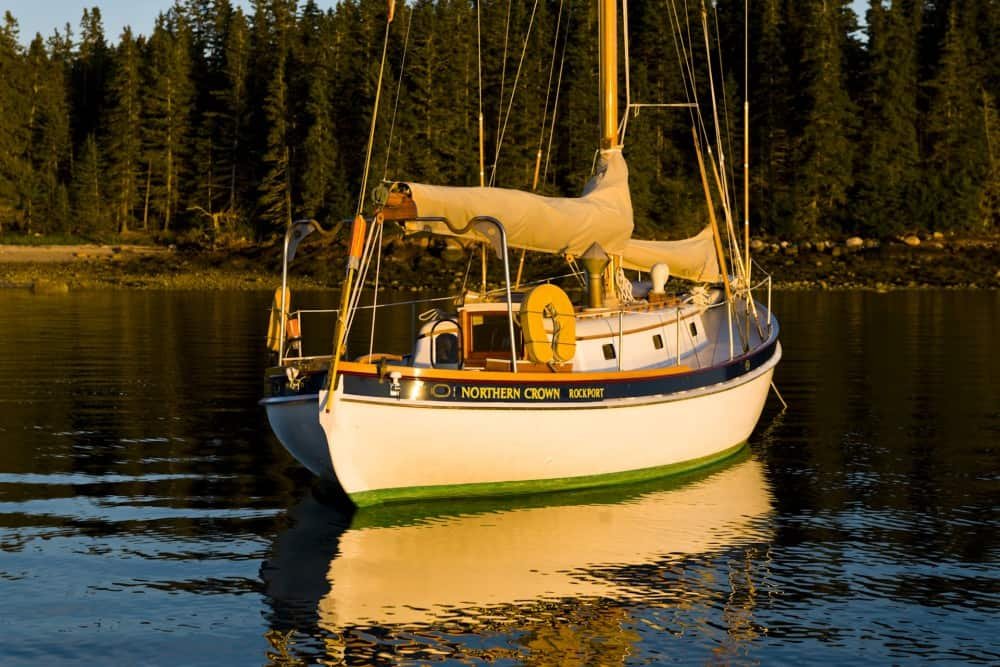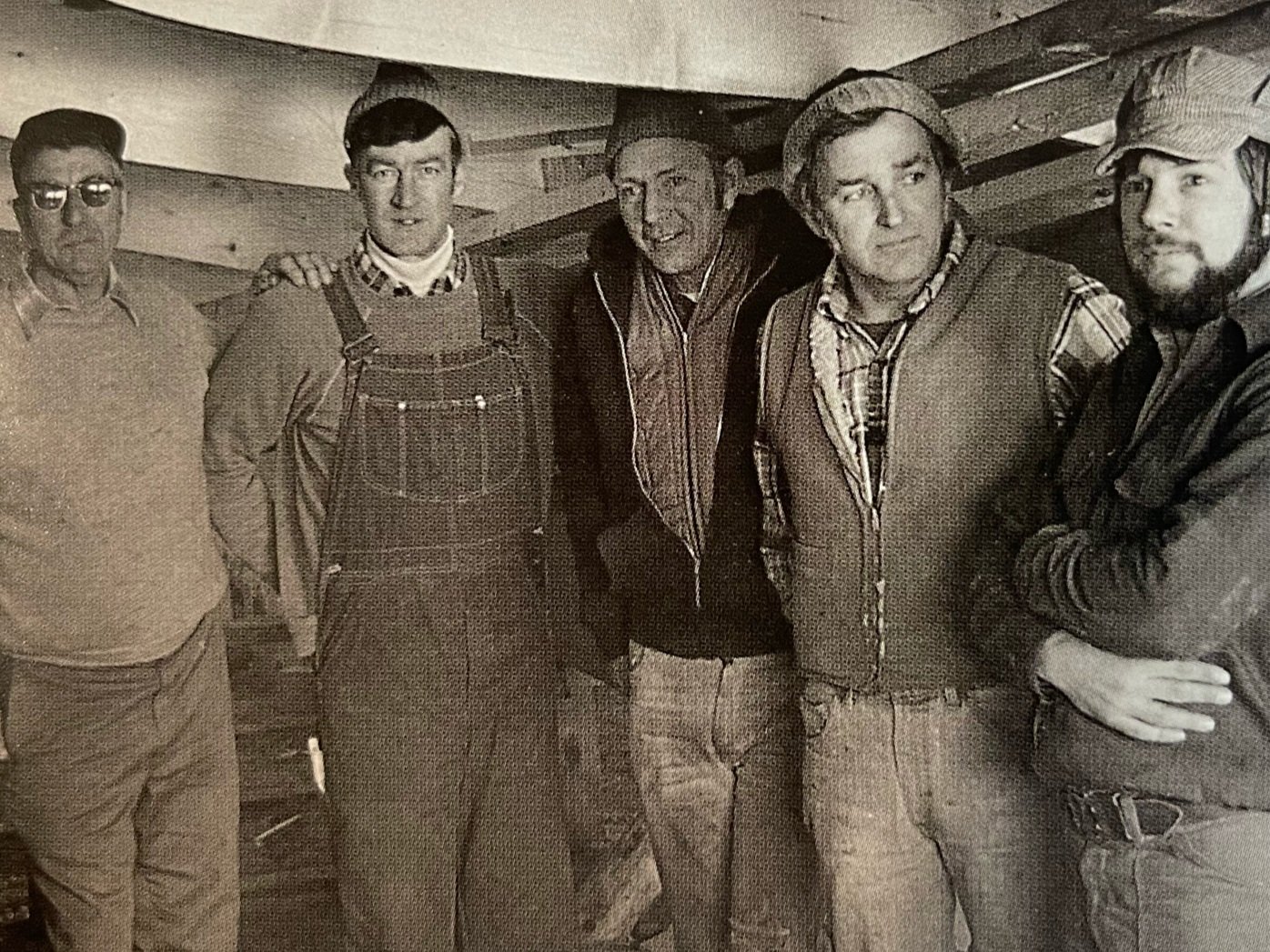
Joel White Designs 1960-1995
“His skills with tools were amazing— God-given, one concludes, if only because he could never explain precisely how he came by them. Watching him work, one quickly realized that a plane or a chisel was an extension of his hands; a way of expressing design ideas by the most tangible means possible.”
Bill Mayher, from the book, Joel White
Below are most of the hand-drawn plans of Joel’s we have in our possession. We have digitized these plans so you can view the magic of Joel’s talent. We have noted dates and bits of history about his designs based on what we remember and what Maynard Bray and Bill Mayher, two of Joel’s closest friends, recall. Should you find yourself wanting complete sets of plans, contact us or visit the WoodenBoat store where fourteen of his plans are offered for sale.
Joel White Design Archive
7’7” Nutshell Pram
Joel designed the first Nutshell Pram, Sarah’s Swallow, for Maynard Bray’s daughter, Sarah. The boat was built as a prototype to determine what needed to be fine-tuned for the final design.
9’6” Martha’s Tender
In addition to being the first boat Steve White helped build as a boy, Martha’s Tender was designed to be simple to build, easy to row, reasonably stable, and above all, to tow well behind whatever craft she was tender to. Later on, Joel drew up a sailing rig along with a centerboard trunk and rudder, so those who planned on building Martha’s Tender could sail as well as row or motor.
9’6” Nutshell Pram
After the prototype Nutshell Pram was designed, built and tested, Joel refined the design and drew up a larger version. The WoodenBoat store sells the building plans for both sizes and as a result, hundreds of these boats exist all over the world- a reminder that one of Joel White’s simplest design is one of his best.
10’4” Sailing Dinghy (1983)
This 10’4” lapstrake sailing dinghy is an earlier adaptation of a traditional design built for lapstrake plywood. It preceded the Nutshell and Shellback designs.
11’2” Shellback Dinghy
Joel designed two Shellback Skiffs, a faster version of the Nutshells, the theme that gave the Shellback its name. The Nutshell and the Shellback are very similar, but the Shellback has a pointed bow, a narrower bottom, and a sharper stern at the waterline.
12’4” Yankee Tender
Like the Nutshell and Shellback designs, the Yankee Tender plans are also available from WoodenBoat store. The Yankee Tender is a cedar-planked, flat-bottomed skiff that weighs less than 150 pounds and can be rigged to sail. Its design was a collaboration between Joel, Jon Wilson, Spencer Lincoln and Maynard Bray based on Mystic Seaport’s Asa Thomson Skiff. Building plans for the hull were drawn by Spencer Lincoln. Joel designed and drew the sailing version.
12’10” Pooduck Skiff (1990)
The Pooduck Skiff is a slightly larger version of the Shellback design with heavier construction and added length for a small jib.
13’ Double-ended Martha’s Tender
The double-ended version of Martha’s Tender was designed for pushing off of a beach into waves. The first of these designs was built for Joel’s son, John, a lobsterman, as a means for reaching his moored lobsterboat.
13' Lapstrake Plywood Outboard Tender (1991)
A versatile row-motor-sail boat of lapstrake plywood that carries its outboard in a well.
He thought a rowboat should do more than bring us out to the mooring. Each time we set out, it should remind us of the fun and elegance of rowing.
Bill Mayher
14’ Peapod (1998)
Joel’s design of the east coast peapod is much like those built by Jimmy Steele, the well-known builder of Downeast Peapods. Joel’s design was commissioned by Ted Leonard, a longtime friend and benefactor, who ordered the first boat. Plans are available at the WoodenBoat store.
15’ Beach Cruiser
A concept drawing of a sloop-rigged beach cruiser having a small fore deck and kick-up rudder.
15’ Guide Boat (1990)
This guide boat proposal was designed for local boatbuilder, Eric Dow, whose customer admired Adirondack Guideboats but desired simpler construction.
15' Marsh Cat Catboat (1987)
Joel designed this catboat for Sam Holdsworth to sail in the shallow waters of Ipswich Bay. It was one of Brooklin Boat Yard’s earliest using cold-molded construction.
16' Haven 12 1/2 Class Sloop (1985)
This shallow-draft, trailerable version of the much-loved Herreshoff 12 1/2 sloop (named for its waterline length) was commissioned by Sam Neill to be trailed between his lakeside cottage in New Hampshire and Brooklin. There are nine sheets of Joel White plans and a how-to-build book by Maynard Bray, both sold at the WoodenBoat store. Of jaw-dropping beauty and sophisticated construction, it’s a popular design, some eighty boats of either plank-on-frame or cold-molded having been built locally by Eric Dow.
16' Shearwater Double Ended Pulling Boat (1984)
Inspired by the narrow and handsome Norwegian faerings, Joel designed the Shearwater and included a small sailing rig. Plans contain eight sheets and can be purchased at the WoodenBoat store.
18' Double Ended Pulling Boat (1997)
This larger version of the Shearwater for two rowers was commissioned by a client in Camden, Maine.
18' Electric Launch (1991)
Proposal drawing for a lightweight launch with low horsepower electric propulsion.
19' Outboard Runabout (1991)
One of three deep-V lines plans of an outboard runabout drafted for production boatbuilder, Skiff Craft.
His was the world of traditional wooden boats and yachts. And he was not interested in self-aggrandizement. He was not seeking monuments to himself. His boats were adorned with nothing unnecessary.
Jonathan Wilson
20' Bangor Packet Rowing Wherry (1981)
Ted Leonard, a longtime friend and client of Joel’s, commissioned this exercise wherry for himself. to use for regular exercising. “She is a fun boat to row!” Leonard said of the boat he named Bangor Packet. She’s of light-and-strong cold-molded construction and is very, very beautiful.
20' Outboard Garvey (1988)
Jim Brown arranged for this design through WoodenBoat on behalf of the Mosquito Indians as a viable substitute for their log canoes. About a dozen Mosquito Indians traveled to Brooklin one autumn to learn how to build plank-on-frame construction by building a boat to this design as well as another larger one.
20' Outboard Cruiser (1987)
An efficient outboard cruiser concept drawing. What a neat boat this would be!
20' Outboard Launch (1995)
The second of three versions designed for a production boat manufacturer.
20' V Bottom Sloop (1983)
Todd Cheney, a local resident, commissioned this design with a round stern and open centerboard.
20'3" Flatfish (1995)
Maynard Bray said, “The twelve-and-a-half worked so well, we had to do it,” about this widened version of the Herreshoff Fish Class and similar Joel White-designed 12’5” sloop.
20'10" Outboard Runabout (1991)
One of several concept drawings Joel made for his photographer friend, Ben Mendlowitz, when Ben was searching for a more suitable photoboat.
22' Centerboard Sloop (1991)
Slightly smaller, Joel’s centerboard version of the Bridges Point 24.
22' Double Ended Sloop (1986)
Also called the Fox Island, this design was commissioned by Jeff Heath of Vinalhaven and is available via the WoodenBoat store. She is an elegant, lapstrake double-ended sloop with fin keel and spade rudder designed for efficient, upside down construction.
Joel drew so clean and fast, some conclude he had the power to see the shape of a boat while in his mind's eye before he struck the first line.
Bill Mayher
22'8" Outboard Runabout (1996)
The final of three versions designed for a production boat builder.
23' Centerboard Sloop (1992)
These plans contain thirteen sheets and are available via the WoodenBoat store. She is an elegant, centerboard daysailer offering high performance and a shallow draft.
23' Outboard Cruiser (1983)
Commissioned by Tom Watson, these preliminary plans are of a contemporary cabin cruiser.
24' Bridges Point Sloop (1984)
Described by Bill Mayher as the perfect boat for Eggemoggin Reach, the 24’ Bridges Point Sloop is speedy, seakindly and seaworthy enough to point its nose into Jericho Bay and beyond. Bill says, “This boat displayed Joel’s incredible love of being in a boat.” Both Bill and Joel owned one of these boats, and according to Bill, Joel sailed his Ellisha more than any other. Designed for Wade Dow who built around eighty of them- some with pointed cabins and some with larger cruising cabins with flat fronts- their fiberglass hulls are still in production by Bridges Point Boat Company on Mount Desert Island.
24' Electric Launch (1997)
An early design of Joel’s, this is a 24’ electric launch with a double ended stern. Bill Mayher says, “Joel was very concerned about the stern in double-ended boats- they had to have sufficient buoyancy (aka floating power) in order to precent ‘digging down’ as the boat gained speed.”
24'6" Sloop (1981)
Designed for Robert Logan, this is a full keel gaff-rigged cruising sloop concept with an outboard hung rudder. It’s much like an enlarged Herreshoff fish class sloop with a trunk cabin and basic accommodations.
26' Daysailer Ketch (1991)
A lovely little keel ketch with a generous self-bailing cockpit that will hold a crowd for daysailing and a small cabin set up for two-person overnighting. Plans are detailed for plank-on-frame construction.
27' Power Cruiser (1990)
Using a lobsterman-type hull designed by Arno Day, Joel drew up a cabin, cockpit and interior to create this very attractive little cruiser for two.
28'3" Munroe Egret Sharpie (1983)
This is Joel’s modified version of the Commodore Munroe’s sharpie, Egret, whose original plans were lost. For WoodenBoat, Joel developed these plans with Dave Dillion, based ton photos, half models and other material. There are eleven sheets contained in this set of plans.
Center Harbor 31
Joel based the Center Harbor 31 on Herreshoff’s Quiet Tune, a much-loved 29’6” ketch. The first Center Harbor 31 was Grace, also ketch-rigged but with more sail area and having a shallow fin keel and spade rudder. She was followed by seven others, all sloops with deeper fin keels. Over the years, each build has incorporated modifications and improvements. Pictured right are all of the Center Harbor 31s built at Brooklin Boat Yard.
28'6" Belford Gray Sloop for Wooden Boat
For construction at WoodenBoat, Joel modified the plans for a 28’ Belford Gray to include less sail area than the original Friendship sail plan.
29' Northern Rose Sloop (1986)
These plans for Northern Rose are the result of Joel’s reimagining of his own boat, Northern Crown; in fact, one could call this a “junior version.” She boasts Joel’s quintessential, full-volume double-ended stern and is designed for strip planking.
32' Admiral's Barge Water Taxi (1989)
This is a Mediterranean-inspired water taxi, a Venetian limo.
32' Herreshoff Buzzards Bay (1994)
Joel modified the plans of Herreshoff’s Buzzards Bay for cold-molded construction.
32' Lark Power Cruiser (1985)
This plank-on-frame power cruiser design was commissioned by Tom Welsh.
32' Mimi Rose Cutter (1982)
Joel took over the design of this handsome cruiser from Bob Baker, Naval Architect. It was completed for his longtime friend, Bill Page.
33' Keloose Modified Concordia (1984)
34' High Time Power Cruiser (1975)
Commissioned by Bill Page for a resident of New Brunswick, Gerry Peer, this plan is a modification of the Concordia 33.
This picnic boat was designed for a good friend and neighbor of Joel’s, Peg Hunt. High Time was built at Brooklin Boat Yard. She is another example of a lobsterboat-inspired design.
34' Mussel Steel Workboat (1975)
This boat was designed for Russ Devereau for multi-purpose use in marine construction.
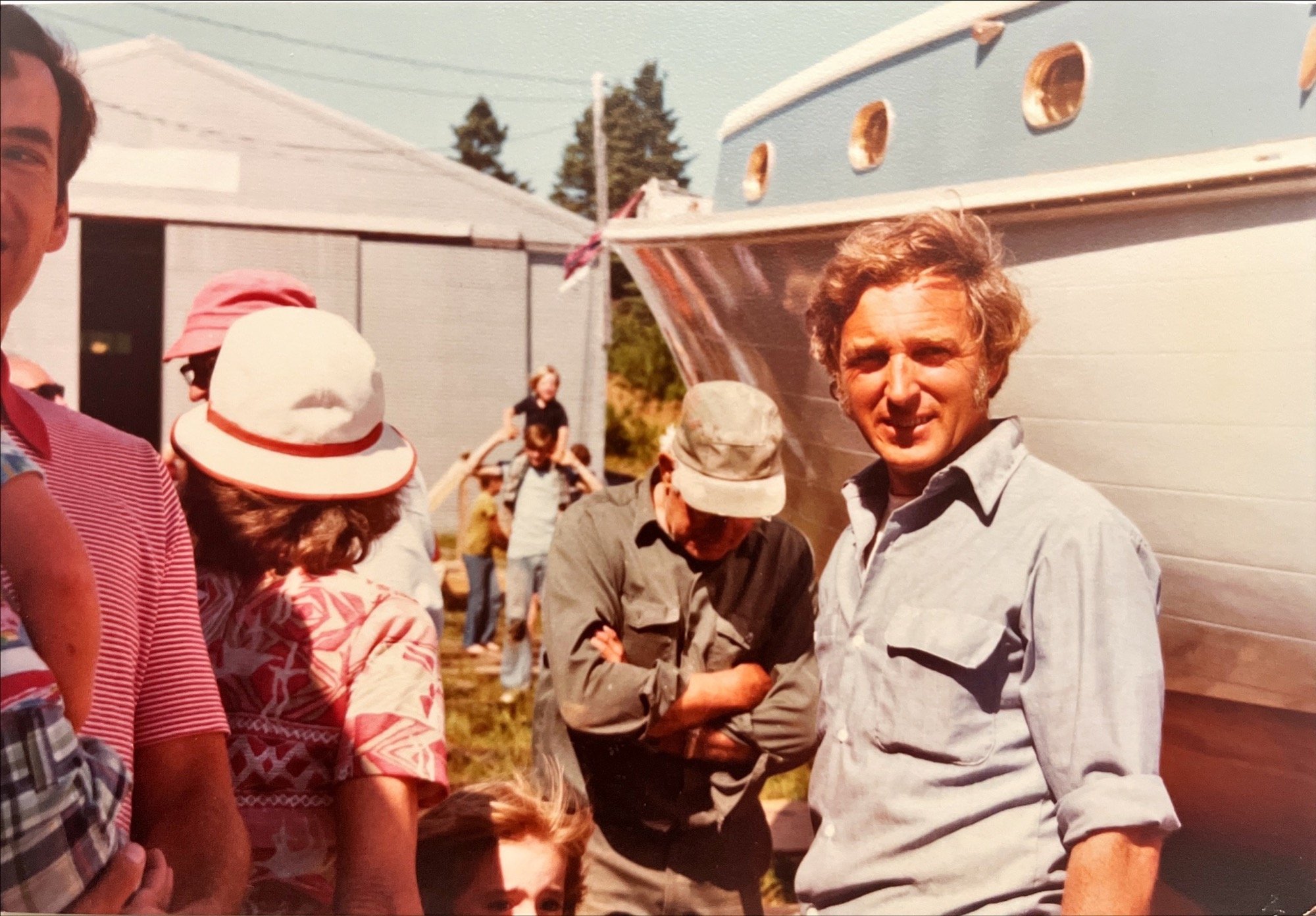
Before he took over Brooklin Boat Yard, Joel built several lobsterboats working for Arno Day. Both High Time and Lady Jeanne's designs were heavily informed by his knowledge of lobsterboat hull shape and construction.
35' Cachalot Sloop (1969)
Cachalot was commissioned by a childhood friend of Joel’s, Peter Sturteven whose only criteria was 1) the cabin had to accommodate a person who was 6’4” and 2) it could be built for less than $25,000.
35' Forthright Cutter (1983)
Commissioned by builder, Gordon Swift, this is a Carlson Cutter and contains eight sheets of plans.
35' Handicap Access Launch (1997)
Joel drew this concept of a handicap-accessible launch for client, Rick Curry.
36' Alisande Ketch (1980)
The design of Alisande followed Dovekie- she is described as “a remarkable boat” by Maynard Bray and Bill Mayher. This design was commissioned by K. Faulkner who pulled a small drawing of William Hand’s Fundulus out of a book. Joel took it from there and drew the plans from which Brooklin Boat Yard built the boat. Laid out at first with the small trunk cabin and generous bridge deck of Fundulus, Brooklin Boat Yard later lengthened the cabin to Joel’s revised drawings.
38' Twin Screw Power Cruiser (1988)
This was a proposal sketch for a 38’ flybridge power cruiser, possibly for fiberglass construction.
40' Leeway Power Cruiser (1978)
One of two proposed layouts for fiberglass-hulled Webbers Cove 40.
40'2" Sloop (1998)
This concept sketch is one of two proposed enlargements of the Center Harbor 31.
40'6" Ketch (1997)
This is the second proposed enlargement of the Center Harbor 31 design, rigged as a ketch.
42' Corsair Cutter (1992)
Joel drew up this short-masted cutter rig for the schooner, Corsair, with a cautionary note about the boat’s lack of stability.
On Tuesday morning, on awakening at 6:30 A.M., land was close aboard to starboard. And what land! Great volcanic peaks, many with cones partially blasted away on one side, and great dark lava flows running towards the sea— the island of Lanzarote, Canary Islands.
Joel’s Transatlantic Diary aboard Integrity (Lisbon, Portugal > Caribbean)
November 13, 1969
42' Everglades Cabin Launch (1994)
Designed for Mike and Erin Matheson, this cabin launch was designed for the Intercoastal Waterway and fiberglass construction.
42' Lady Jeanne Power Cruiser (1979)
Lady Jeanne, now Woody, was an early design of Joel’s, and many of her lines and shapes are inspired by Maine lobsterboats. She was originally designed for client, Joel Merkel.
42' Power Cruiser (1983)
This is a concept sketch of a power cruiser for client Jim Lavinson.
42' Sweet Olive Cruising Ketch (1989)
One of the last plank-on-frame building projects at Brooklin Boat Yard, Sweet Olive still calls Center Harbor her home. She was first designed and built for K. Faulkner as a replacement for Alisande. She was also used in the sailing program at Wooden Boat.
43'6" Cirrus (1987)
Cirrus marks the first boat that Joel was paid to design as a Naval Architect. He converted Herreshoff’s Fisher’s Island 31 from a sloop to a yawl. The modification design was commissioned by client, Allen Beemus.
44' Cruising Cutter (1994)
This is a concept sketch for a lapstrake cruising cutter for client, Peter Nichols.
44' Yawl (1992)
A proposed clipper-bow schooner with three headsails and two topmasts.
45' Boss Lady Power Cruiser (1996)
Joel designed Boss Lady for Luke Allen of Rockport Marine to built there as his personal yacht. She’s since changes hands and presently calls Eggemoggin Reach her port.
45' Clipper-bow Schooner (1987)
A proposal, much like Sweet Olive with a yawl rig, for Woodson K. Woods.
Rob Eddy, Off Center Harbor
Northern Crown, Joel’s Boat
Designed by K. Aage Nielsen
Built by Walsted Yard in Thuro, Denmark
Much of the charm of small wooden boats is that the structure itself becomes an integral part of the interior decor. On Northern Crown, the first thing visible from one’s bunk is the cabintop, with its beaded barrow planks paid over closely-spaced cabin beams. Because of her heavily rounded corners where cabintop meets the cabin sides, these beams are not simple arcs of circles, but rather have a more elliptical shape.
The clever Danes who built her took the time to ovalize the bottom edges of these beams— perhaps to lessen the damage to one’s head in a close encounter— but, I suspect, simply because it brings a hint of elegance to the work, and signifies that care is being taken with all the elements of the job. Written by Joel White
45' Culler Vintage Scow Schooner (1985)
Joel made additional drawings to clarify those of Peter Culler when Brooklin Boat Yard built the scow schooner Vintage for Jim and Lolly Mitchell.
45' Fast Power Cruiser (1990)
This design is an express power cruiser with a deep “V” and open stern.
45' Motorsailer
Round-stern, cutter-rigged motorsailer proposal for Covey Island Boatworks in Nova Scotia.
50' Maine Idea Power Cruiser (1981)
Maine Idea was built at Brooklin Boat Yard and Joel designed her for the Martins of Blue Hill, a local summer family. Her hull is workboat-inspired but has an unusual amount of enclosed accomodation.
56' Fast Cruising Sloop (1994)
This is the first concept drawn for Kim Bottles and inspired by Scandinavian skerry cruisers—a bigger version of the 30 square meter that the Bottles currently owned.
60' Nichole Scalloper (1977)
This scallopdragger was designed for a commercial fisherman and built by Newbert & Wallace in Thomaston, ME. This plan contains eight sheets.
62'2" Fast Cruising Sloop (1994)
The Bottles finally settled on this and Joel drew a full set of plans consisting of ten sheets. Sadly, the boat was never built.
67' Ketch (1996)
When Sonny and Tim Hodgden came to Joel for some proposals, this is one of several that he came up with.
72' Motor Yacht (1992)
Another, yet larger, proposal for longtime client, Alan Stern.
Dragonera 1993
Dragonera was built in one year despite her size. After launch, she went through minimal sea trials before embarking on a journey to Bermuda. On her first voyage, she encountered a fierce Gulf Stream gale that required heaving to under staysail and reefed mizzen for twenty-one hours. She emerged undamaged except for a bent stern pulpit, a true testament of her sound design and construction.
A Study of Bows
A simple sketch of different bow shapes.
Bronze Shackle (1993)
A detailed sketch of an easily-made bronze block.
All Purpose Mallet
This straightforward caulking mallet was designed by Joel to illustrate an article he wrote for wooden boat magazine.
Joel reflects on his first experiences sailing with his father, E.B. White, in Coastal Maine.
The following are Joel’s own words as published in the book, Joel White, by Bill Mayher and Maynard Bray:
I became interested in boats at an early age- my father was boat crazy and passed that rogue gene on to me. My earliest boating memory is of standing on a dock in City Island, NY, looking down onto the deck of a pretty double-ended cutter named Astrid. Her hull was white. Her decks light green set off by darker green trim and guardrails. Her wooden spars were painted an orange buff color and her furled sails were of khaki canvas. Her massive tiller was varnished, of an unknown southern hardwood with a strong grain pattern. It was 1935 and my dad had just purchased Astrid for use around our home waters in Maine. She was a Larry Huntington design- 30 feet in length with a raised deck amidships to give headroom. (She actually provided headroom for my mother who was 5' tall, and for me, who was five. My dad, who was 5'10" had to stoop a little.) After the delivery trip to Maine, she was a summertime member of the family, hanging to her mooring in Allen Cove in Blue Hill Bay, and transporting us on many a day sail, short cruise, or perhaps most common of all, a mackerel fishing expedition. Mackereling was a big summer occupation in those days, and the schools were numerous and bountiful. They were caught by chumming, attracting the schools to the boat with chumbait made of ground-up clams, oatmeal, cornmeal, and vegetable or olive oil. The fish were caught on weighted jigs at the end of a light handline, baited with a clam. It was not uncommon to catch 200-300 in an afternoon, sharing the catch with friends and neighbors and putting up many of them in jars to eat next winter.
My most vivid recollection of Astrid is of her smells. She was built in Florida of southern cedar, and its strong aroma was always present aboard. In addition there was the slight presence of kerosene, from the running lights stored in the forepeak, tarred marlin in the brown ditty bag, and just a trace of mothballs, left over from last winter's storage of the bright red Hudson's Bay blankets on her main cabin bunks. Sometimes a whiff of gasoline from the Palmer auxiliary behind the companionway ladder, and traces of breakfast bacon.
I liked everything about the short cruises I took with my father- the preparations beforehand when we collected food, ice, clothing, and drinks on the shore which were rowed out to Astrid in her eight-foot dinghy. I liked casting off the home mooring and bearing away for new places, the ebb and flow of the strong Maine tides, the selection of the destination for the night, and the splash of the kedge going down in the late afternoon. I liked the warmth of the Shipmate stove fired with short pieces of wood or charcoal briquettes. I liked the boat meals cooked on the Shipmate, the washing up afterwards in the tiny sink. Most of all I liked the snug feeling of bedtime in the forward pipe berth, the gurgles and slap of water against the hull, the creak of the anchor rode on the bowsprit roller as a small puff swung her in some deserted, spruce-rimmed cove. Waking early in the low, strong morning light, I would creep on deck to examine the new day and imagine its pleasures yet to be.
This joy of cruising has never left me--it remains undiminished sixty years after those first early trips. The same simple pleasures still delight, just as they did when I was only eight or nine.



